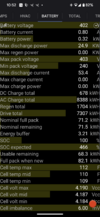Hello. I want to start this off by saying that I understand these cars and I get that the batteries don't last forever, etc etc. However, I know that the media tends to be saying that these cars don't have batteries that degrade that much. From these articles, I was expecting about 4-8 percent in the first year and then for it to level off.
I have a 2021 refresh (but not the 82 kWh battery) long range model 3, that has about 35k miles on it. Today, I finally got the chance to test for myself what the degradation would be; no more Tessie guess-o-meter. I would be taking this car from 100 to zero in one trip at ~75 mph with ac off, etc.
I knew things were bad when I reached 50%, I had only pulled 32 kWh for a 64 kWh total. Not even close to the ~75kwh the battery supposedly had to start with.
When it hit zero, I had pulled 63KWh from the battery in total. Comparing that to 75KWh gives me a whopping 16 percent degradation. Oh my God.
The car is not abused. About a third of its charging is done supercharging, the rest level 1 or 2. It does sit outside, but it is in the shade in the relatively mild North Carolina climate. I know Bjorn put out a video a few weeks ago that showed a 2021 with significant degradation. Could these cars have issues? Maybe.
Is anyone else experiencing anything like this? I expected this car to last at least 100k miles. Also, yes, I feel the degradation. That 100-0 trip was only 206 miles. The car is also horribly inefficient now since I got Michelin Pilot Sport All season 4s on it. 340 wh/mile at 78 mph. I used to get 290 on the old mxm4s.
The good news is that I'll be ditching this thing pretty soon for a highland. Can't wait for the extra efficiency and range from the slightly larger battery.




